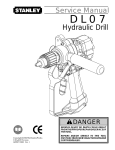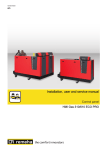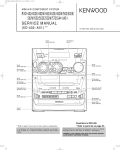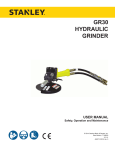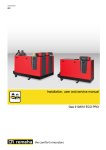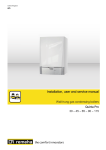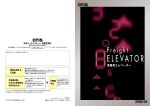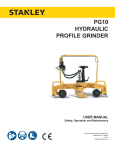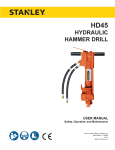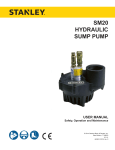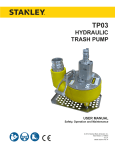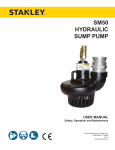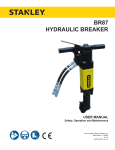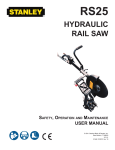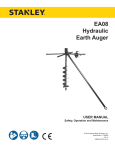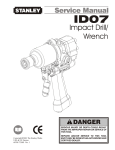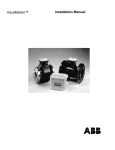Download DL07 User Manual
Transcript
DL07 HYDRAULIC DRILL USER MANUAL Safety, Operation and Maintenance © 2014 Stanley Black & Decker, Inc. New Britain, CT 06053 U.S.A. 49234 2/2015 Ver. 10 DECLARATION OF CONFORMITY DECLARATION OF CONFORMITY ÜBEREINSTIMMUNGS-ERKLARUNG DECLARATION DE CONFORMITE CEE DECLARACION DE CONFORMIDAD DICHIARAZIONE DI CONFORMITA Hydraulic Tools ______________________________________________________________________ I, the undersigned: Ich, der Unterzeichnende: Je soussigné: El abajo firmante: lo sottoscritto: Weisbeck, Andy Surname and First names/Familiennname und Vornamen/Nom et prénom/Nombre y apellido/Cognome e nome hereby declare that the equipment specified hereunder: bestätige hiermit, daß erklaren Produkt genannten Werk oder Gerät: déclare que l’équipement visé ci-dessous: Por la presente declaro que el equipo se especifica a continuación: Dichiaro che le apparecchiature specificate di seguito: Drill, Hydraulic 1. Category: Kategorie: Catégorie: Categoria: Categoria: 2. Make/Marke/Marque/Marca/Marca 3. Type/Typ/Type/Tipo/Tipo: 4. Serial number of equipment: Seriennummer des Geräts: Numéro de série de l’équipement: Numero de serie del equipo: Matricola dell´attrezzatura: Stanley DL0755001, DL0765201 All Has been manufactured in conformity with Wurde hergestellt in Übereinstimmung mit Est fabriqué conformément Ha sido fabricado de acuerdo con E’ stata costruita in conformitá con Directive/Standards Richtlinie/Standards Directives/Normes Directriz/Los Normas Direttiva/Norme No. Nr Numéro No n. Approved body Prüfung durch Organisme agréé Aprobado Collaudato ISO ISO ISO Machinery Directive 3744:2010 20643:2005 11148-3:2010 2006/42/EC:2006 Self Self Self Self 5. Special Provisions: None Spezielle Bestimmungen: Dispositions particulières: Provisiones especiales: Disposizioni speciali: 6. Representative in the Union: Patrick Vervier, Stanley Dubuis 17-19, rue Jules Berthonneau-BP 3406 41034 Blois Cedex, France. Vertreter in der Union/Représentant dans l’union/Representante en la Union/Rappresentante presso l’Unione Done at/Ort/Fait à/Dado en/Fatto a Stanley Hydraulic Tools, Milwaukie, Oregon USA Signature/Unterschrift/Signature/Firma/Firma Position/Position/Fonction/Cargo/Posizione 2 ► DL07 User Manual Director of Product Development Date/Datum/le/Fecha/Data 1-4-11 TABLE OF CONTENTS DECLARATION OF CONFORMITY...........................................................................................................................2 SAFETY SYMBOLS...................................................................................................................................................4 SAFETY PRECAUTIONS...........................................................................................................................................5 TOOL STICKERS & TAGS.........................................................................................................................................6 HOSE TYPE...............................................................................................................................................................7 HOSE RECOMMENDATIONS...................................................................................................................................8 FIGURE 1. TYPICAL HOSE CONNECTIONS........................................................................................................8 HTMA REQUIREMENTS............................................................................................................................................9 OPERATION.............................................................................................................................................................10 TOOL PROTECTION & CARE.................................................................................................................................12 TROUBLESHOOTING.............................................................................................................................................13 SPECIFICATIONS....................................................................................................................................................14 TORQUE AND DRILL SPEEDS...............................................................................................................................14 ACCESSORIES.......................................................................................................................................................15 DL07 PARTS ILLUSTRATION..................................................................................................................................16 DL07 PARTS LIST....................................................................................................................................................17 UNDERWATER TOOLS DEPTH GUIDELINE..........................................................................................................18 IMPORTANT To fill out a Product Warranty Validation form, and for information on your warranty, visit Stanleyhydraulics.com and select the Company tab, Warranty. (NOTE: The warranty Validation record must be submitted to validate the warranty). SERVICING: This manual contains safety, operation, and routine maintenance instructions. Stanley Hydraulic Tools recommends that servicing of hydraulic tools, other than routine maintenance, must be performed by an authorized and certified dealer. Please read the following warning. WARNING SERIOUS INJURY OR DEATH COULD RESULT FROM THE IMPROPER REPAIR OR SERVICE OF THIS TOOL. REPAIRS AND / OR SERVICE TO THIS TOOL MUST ONLY BE DONE BY AN AUTHORIZED AND CERTIFIED DEALER. For the nearest authorized and certified dealer, call Stanley Hydraulic Tools at the number listed on the back of this manual and ask for a Customer Service Representative. DL07 User Manual ◄ 3 SAFETY SYMBOLS Safety symbols and signal words, as shown below, are used to emphasize all operator, maintenance and repair actions which, if not strictly followed, could result in a life-threatening situation, bodily injury or damage to equipment. This is the safety alert symbol. It is used to alert you to potential personal injury hazards. Obey all safety messages that follow this symbol to avoid possible injury or death. DANGER This safety alert and signal word indicate an imminently hazardous situation which, if not avoided, will result in death or serious injury. WARNING This safety alert and signal word indicate a potentially hazardous situation which, if not avoided, could result in death or serious injury. CAUTION This safety alert and signal word indicate a potentially hazardous situation which, if not avoided, could result in death or serious injury. CAUTION This signal word indicates a potentially hazardous situation which, if not avoided, may result in property damage. NOTICE This signal word indicates a situation which, if not avoided, will result in damage to the equipment. IMPORTANT This signal word indicates a situation which, if not avoided, may result in damage to the equipment. Always observe safety symbols. They are included for your safety and for the protection of the tool. LOCAL SAFETY REGULATIONS Enter any local safety regulations here. Keep these instructions in an area accessible to the operator and maintenance personnel. 4 ► DL07 User Manual SAFETY PRECAUTIONS Tool operators and maintenance personnel must always comply with the safety precautions given in this manual and on the stickers and tags attached to the tool and hose. • These safety precautions are given for your safety. Review them carefully before operating the tool and before performing general maintenance or repairs. Always connect hoses to the tool hose couplers before energizing the hydraulic power source. Be sure all hose connections are tight and are in good condition. • Do not operate the tool at oil temperatures above 140 °F/60 °C. Operation at higher temperatures can cause higher than normal temperatures at the tool which can result in operator discomfort. • Do not operate a damaged, improperly adjusted, or incompletely assembled drill. • Never wear loose clothing that can get entangled in the working parts of the tool. • Keep all parts of your body away from the rotating parts. Long hair or loose clothing can become drawn into rotating components. • Always use accessories that conform to the specifications given in the OPERATION section of this manual. • Do not reverse impact wrench rotation direction by changing fluid flow direction. • Release the trigger if the power supply has been interrupted. • When working near electrical conductors, always assume that all conductors are energized and that insulation, clothing and hoses can conduct electricity. Use hose labeled and certified as non-conductive. • To avoid personal injury or equipment damage, all tool repair, maintenance and service must only be performed by authorized and properly trained personnel. • Do not carry the tool by hoses. • Warning: Use of this tool on certain materials during demolition could generate dust potentially containing a variety of hazardous substances such as asbestos, silica or lead. Inhalation of dust containing these or other hazardous substances could result in serious injury, cancer or death. Protect yourself and those around you. Research and understand the materials you are cutting. Follow correct safety procedures and comply with all applicable national, state or provisional health and safety regulations relating to them, including, if appropriate arranging for the safe disposal of the materials by a qualified person. Supervising personnel should develop additional precautions relating to the specific work area and local safety regulations. If so, place the added precautions in the space provided in this manual. The model DL07 Hydraulic Drill will provide safe and dependable service if operated in accordance with the instructions given in this manual. Read and understand this manual and any stickers and tags attached to the tool and hose before operation. Failure to do so could result in personal injury or equipment damage. • The operator must start in a work area without bystanders. Flying debris can cause serious injury. • Do not operate the tool unless thoroughly trained or under the supervision of an instructor. Establish a training program for all operators to ensure safe operation. • Always wear safety equipment such as goggles, ear and head protection, and safety shoes at all times when operating the tool. Use gloves and aprons when necessary. • The operator must be familiar with all prohibited work areas such as excessive slopes and dangerous terrain conditions. • Maintain proper footing and balance at all times. • Do not inspect or clean the tool while the hydraulic power source is connected. Accidental engagement of the tool can cause serious injury. DL07 User Manual ◄ 5 TOOL STICKERS & TAGS Please refer to the parts illustration for location of stickers. Stanley Hydraulic Tools 3810 SE Naef Road Milwaukie, Oregon USA 4-12 GPM/15-45 LPM 26-45 LPM / 7-12 GPM 2000 PSI / 140/ 2000 BARPSI 140 BAR Model No. DL07 IW16 28322 CE STICKER (CE) 58862 PRESSURE WARNING STICKER 60807 DL07 MODEL STICKER WARNING D 30 LPM @ 138 B AR EHTMA CATEGORY 11207 CIRCUIT TYPE D STICKER (CE) 58864 ELECTRICAL WARNING STICKER OC/CC 28788 MANUAL STICKER (CE) FOR USE ON OPEN CENTER AND CLOSED CENTER HYDRAULIC SYSTEMS. “SET FOR PROPER SYSTEM BEFORE USE” RATED NO-LOAD SPEED 1000 RPM AT 8 GPM/30 LPM 29148 RPM STICKER 11354 OC/CC STICKER NOTE THE INFORMATION LISTED ON THE STICKERS SHOWN, MUST BE LEGIBLE AT ALL TIMES. REPLACE DECALS IF THEY BECOME WORN OR DAMAGED. REPLACEMENTS ARE AVAILABLE FROM YOUR LOCAL STANLEY DISTRIBUTOR. D A N G E R 1. FAILURE TO USE HYDRAULIC HOSE LABELED AND CERTIFIED AS NON-CONDUCTIVE WHEN USING HYDRAULIC TOOLS ON OR NEAR ELECTRICAL LINES MAY RESULT IN DEATH OR SERIOUS INJURY. BEFORE USING HOSE LABELED AND CERTIFIED AS NONCONDUCTIVE ON OR NEAR ELECTRIC LINES BE SURE THE HOSE IS MAINTAINED AS NON-CONDUCTIVE. THE HOSE SHOULD BE REGULARLY TESTED FOR ELECTRIC CURRENT LEAKAGE IN ACCORDANCE WITH YOUR SAFETY DEPARTMENT INSTRUCTIONS. 2. A HYDRAULIC LEAK OR BURST MAY CAUSE OIL INJECTION INTO THE BODY OR CAUSE OTHER SEVERE PERSONAL INJURY. A. DO NOT EXCEED SPECIFIED FLOW AND PRESSURE FOR THIS TOOL. EXCESS FLOW OR PRESSURE MAY CAUSE A LEAK OR BURST. B. DO NOT EXCEED RATED WORKING PRESSURE OF HYDRAULIC HOSE USED WITH THIS TOOL. EXCESS PRESSURE MAY CAUSE A LEAK OR BURST. C. CHECK TOOL HOSE COUPLERS AND CONNECTORS DAILY FOR LEAKS. DO NOT FEEL FOR LEAKS WITH YOUR HANDS. CONTACT WITH A LEAK MAY RESULT IN SEVERE PERSONAL INJURY. The safety tag (P/N 15875) at right is attached to the tool when shipped from the factory. Read and understand the safety instructions listed on this tag before removal. We suggest you retain this tag and attach it to the tool when not in use. D A N G E R D. DO NOT LIFT OR CARRY TOOL BY THE HOSES. DO NOT ABUSE HOSE. DO NOT USE KINKED, TORN OR DAMAGED HOSE. 3. MAKE SURE HYDRAULIC HOSES ARE PROPERLY CONNECTED TO THE TOOL BEFORE PRESSURING SYSTEM. SYSTEM PRESSURE HOSE MUST ALWAYS BE CONNECTED TO TOOL “IN” PORT. SYSTEM RETURN HOSE MUST ALWAYS BE CONNECTED TO TOOL “OUT” PORT. REVERSING CONNECTIONS MAY CAUSE REVERSE TOOL OPERATION WHICH CAN RESULT IN SEVERE PERSONAL INJURY. 4. DO NOT CONNECT OPEN-CENTER TOOLS TO CLOSEDCENTER HYDRAULIC SYSTEMS. THIS MAY RESULT IN LOSS OF OTHER HYDRAULIC FUNCTIONS POWERED BY THE SAME SYSTEM AND/OR SEVERE PERSONAL INJURY. 5. BYSTANDERS MAY BE INJURED IN YOUR WORK AREA. KEEP BYSTANDERS CLEAR OF YOUR WORK AREA. 6. WEAR HEARING, EYE, FOOT, HAND AND HEAD PROTECTION. 7. TO AVOID PERSONAL INJURY OR EQUIPMENT DAMAGE, ALL TOOL REPAIR MAINTENANCE AND SERVICE MUST ONLY BE PERFORMED BY AUTHORIZED AND PROPERLY TRAINED PERSONNEL. I M P O R T A N T I M P O R T A N T READ OPERATION MANUAL AND SAFETY INSTRUCTIONS FOR THIS TOOL BEFORE USING IT. READ OPERATION MANUAL AND SAFETY INSTRUCTIONS FOR THIS TOOL BEFORE USING IT. USE ONLY PARTS AND REPAIR PROCEDURES APPROVED BY STANLEY AND DESCRIBED IN THE OPERATION MANUAL. USE ONLY PARTS AND REPAIR PROCEDURES APPROVED BY STANLEY AND DESCRIBED IN THE OPERATION MANUAL. TAG TO BE REMOVED ONLY BY TOOL OPERATOR. TAG TO BE REMOVED ONLY BY TOOL OPERATOR. SEE OTHER SIDE SEE OTHER SIDE SAFETY TAG P/N 15875 (Shown smaller then actual size) 6 ► DL07 User Manual HOSE TYPES The rated working pressure of the hydraulic hose must be equal to or higher than the relief valve setting on the hydraulic system. There are three types of hydraulic hose that meet this requirement and are authorized for use with Stanley Hydraulic Tools. They are: Certified non-conductive — constructed of thermoplastic or synthetic rubber inner tube, synthetic fiber braid reinforcement, and weather resistant thermoplastic or synthetic rubber cover. Hose labeled certified nonconductive is the only hose authorized for use near electrical conductors. Wire-braided (conductive) — constructed of synthetic rubber inner tube, single or double wire braid reinforcement, and weather resistant synthetic rubber cover. This hose is conductive and must never be used near electrical conductors. Fabric-braided (not certified or labeled non-conductive) — constructed of thermoplastic or synthetic rubber inner tube, synthetic fiber braid reinforcement, and weather resistant thermoplastic or synthetic rubber cover. This hose is not certified non-conductive and must never be used near electrical conductors. HOSE SAFETY TAGS To help ensure your safety, the following DANGER tags are attached to all hose purchased from Stanley Hydraulic Tools. DO NOT REMOVE THESE TAGS. If the information on a tag is illegible because of wear or damage, replace the tag immediately. A new tag may be obtained from your Stanley Distributor. D A N G E R D A N G E R 1. FAILURE TO USE HYDRAULIC HOSE LABELED AND CERTIFIED AS NON-CONDUCTIVE WHEN USING HYDRAULIC TOOLS ON OR NEAR ELECTRIC LINES MAY RESULT IN DEATH OR SERIOUS INJURY. FOR PROPER AND SAFE OPERATION MAKE SURE THAT YOU HAVE BEEN PROPERLY TRAINED IN CORRECT PROCEDURES REQUIRED FOR WORK ON OR AROUND ELECTRIC LINES. 2. BEFORE USING HYDRAULIC HOSE LABELED AND CERTIFIED AS NON-CONDUCTIVE ON OR NEAR ELECTRIC LINES. WIPE THE ENTIRE LENGTH OF THE HOSE AND FITTING WITH A CLEAN DRY ABSORBENT CLOTH TO REMOVE DIRT AND MOISTURE AND TEST HOSE FOR MAXIMUM ALLOWABLE CURRENT LEAKAGE IN ACCORDANCE WITH SAFETY DEPARTMENT INSTRUCTIONS. 3. DO NOT EXCEED HOSE WORKING PRESSURE OR ABUSE HOSE. IMPROPER USE OR HANDLING OF HOSE COULD RESULT IN BURST OR OTHER HOSE FAILURE. KEEP HOSE AS FAR AWAY AS POSSIBLE FROM BODY AND DO NOT PERMIT DIRECT CONTACT DURING USE. CONTACT AT THE BURST CAN CAUSE BODILY INJECTION AND SEVERE PERSONAL INJURY. 4. HANDLE AND ROUTE HOSE CAREFULLY TO AVOID KINKING, ABRASION, CUTTING, OR CONTACT WITH HIGH TEMPERATURE SURFACES. DO NOT USE IF KINKED. DO NOT USE HOSE TO PULL OR LIFT TOOLS, POWER UNITS, ETC. 5. CHECK ENTIRE HOSE FOR CUTS CRACKS LEAKS ABRASIONS, BULGES, OR DAMAGE TO COUPLINGS IF ANY OF THESE CONDITIONS EXIST, REPLACE THE HOSE IMMEDIATELY. NEVER USE TAPE OR ANY DEVICE TO ATTEMPT TO MEND THE HOSE. 6. AFTER EACH USE STORE IN A CLEAN DRY AREA. SEE OTHER SIDE SIDE 1 SEE OTHER SIDE (Shown smaller than actual size) DO NOT REMOVE THIS TAG DO NOT REMOVE THIS TAG THE TAG SHOWN BELOW IS ATTACHED TO “CERTIFIED NON-CONDUCTIVE” HOSE SIDE 2 D A N G E R D A N G E R 1. DO NOT USE THIS HYDRAULIC HOSE ON OR NEAR ELECTRIC LINES. THIS HOSE IS NOT LABELED OR CERTIFIED AS NON-CONDUCTIVE. USING THIS HOSE ON OR NEAR ELECTRICAL LINES MAY RESULT IN DEATH OR SERIOUS INJURY. 5. CHECK ENTIRE HOSE FOR CUTS CRACKS LEAKS ABRASIONS, BULGES, OR DAMAGE TO COUPLINGS IF ANY OF THESE CONDITIONS EXIST, REPLACE THE HOSE IMMEDIATELY. NEVER USE TAPE OR ANY DEVICE TO ATTEMPT TO MEND THE HOSE. 2. FOR PROPER AND SAFE OPERATION MAKE SURE THAT YOU HAVE BEEN PROPERLY TRAINED IN CORRECT PROCEDURES REQUIRED FOR WORK ON OR AROUND ELECTRIC LINES. 6. AFTER EACH USE STORE IN A CLEAN DRY AREA. 3. DO NOT EXCEED HOSE WORKING PRESSURE OR ABUSE HOSE. IMPROPER USE OR HANDLING OF HOSE COULD RESULT IN BURST OR OTHER HOSE FAILURE. KEEP HOSE AS FAR AWAY AS POSSIBLE FROM BODY AND DO NOT PERMIT DIRECT CONTACT DURING USE. CONTACT AT THE BURST CAN CAUSE BODILY INJECTION AND SEVERE PERSONAL INJURY. 4. HANDLE AND ROUTE HOSE CAREFULLY TO AVOID KINKING, CUTTING, OR CONTACT WITH HIGH TEMPERATURE SURFACES. DO NOT USE IF KINKED. DO NOT USE HOSE TO PULL OR LIFT TOOLS, POWER UNITS, ETC. DO NOT REMOVE THIS TAG DO NOT REMOVE THIS TAG THE TAG SHOWN BELOW IS ATTACHED TO “CONDUCTIVE” HOSE. SEE OTHER SIDE SEE OTHER SIDE SIDE 1 SIDE 2 (Shown smaller than actual size) DL07 User Manual ◄ 7 8 ► DL07 User Manual All hydraulic hose must meet or exceed specifications as set forth by SAE J517. All hydraulic hose must have at least a rated minimum working pressure equal to the maximum hydraulic system relief valve setting. This chart is intended to be used for hydraulic tool applications only based on Stanley Hydraulic Tools tool operating requirements and should not be used for any other applications. The chart to the right shows recommended minimum hose diameters for various hose lengths based on gallons per minute (gpm)/ liters per minute (lpm). These recommendations are intended to keep return line pressure (back pressure) to a minimum acceptable level to ensure maximum tool performance. Tool to Hydraulic Circuit Hose Recommendations 15-34 MM Inside Diameter INCH USE (Press/Return) PSI up to 10 up to 3 3/8 10 Both 2250 49-60 13-16 FLOW >>> RETURN <<< FLOW PRESSURE 26-100 up to 25 100-200 51-100 up to 50 100-300 51-100 up to 50 26-100 up to 25 8-30 up to 8 30-60 15-30 up to 15 30-90 15-30 up to 15 7.5-30 up to 7.5 Figure 1. Typical Hose Connections 49-60 38-49 10-13 13-16 19-40 5-10.5 38-49 19-40 5-10.5 10-13 19-40 5-10.5 38-49 15-23 10-13 15-23 4-6 19 25.4 16 19 19 25.4 5/8 3/4 3/4 1 19 3/4 1 16 3/4 16 19 3/4 5/8 16 5/8 5/8 16 13 13 10 5/8 1/2 1/2 3/8 Return Pressure Return Pressure Return Pressure Return Pressure Both Return Pressure Both Both Both Both 2500 2500 2500 2500 2500 2500 2500 2500 2500 2500 2500 2500 2500 2500 2500 175 175 175 175 175 175 175 175 175 175 175 175 175 175 175 155 BAR Min. Working Pressure Certified Non-Conductive Hose - Fiber Braid - for Utility Bucket Trucks METERS Hose Lengths FEET Conductive Hose - Wire Braid or Fiber Braid -DO NOT USE NEAR ELECTRICAL CONDUCTORS 4-6 4-9 LPM Oil Flow GPM HOSE RECOMMENDATIONS HTMA / EHTMA REQUIREMENTS HTMA / EHTMA REQUIREMENTS HTMA HYDRAULIC SYSTEM REQUIREMENTS TYPE I Nominal Operating Pressure (at the power supply outlet) 4-6 gpm (15-23 lpm) 1500 psi (103 bar) TOOL TYPE TYPE II TYPE RR 7-9 gpm (26-34 lpm) 1500 psi (103 bar) 9-10.5 gpm (34-40 lpm) 1500 psi (103 bar) System relief valve setting (at the power supply outlet) 2100-2250 psi (145-155 bar) 2100-2250 psi (145-155 bar) 2200-2300 psi (152-159 bar) 2100-2250 psi (145-155 bar) Maximum back pressure (at tool end of the return hose) 250 psi (17 bar) 250 psi (17 bar) 250 psi (17 bar) 250 psi (17 bar) Measured at a max. fluid viscosity of: (at min. operating temperature) 400 ssu* 400 ssu* 400 ssu* 400 ssu* (82 centistokes) (82 centistokes) (82 centistokes) (82 centistokes) Temperature: Sufficient heat rejection capacity to limit max. fluid temperature to: (at max. expected ambient temperature) 140° F (60° C) Flow Range 140° F (60° C) 140° F (60° C) TYPE III 11-13 gpm (42-49 lpm) 1500 psi (103 bar) 140° F (60° C) 3 hp 5 hp 6 hp 7 hp Min. cooling capacity at a temperature (2.24 kW) (3.73 kW) (5.22 kW) (4.47 kW) difference of between ambient and fluid 40° F 40° F 40° F 40° F temps (22° C) (22° C) (22° C) (22° C) NOTE: Do not operate the tool at oil temperatures above 140° F (60° C). Operation at higher temperatures can cause operator discomfort at the tool. Filter Min. full-flow filtration Sized for flow of at least: (For cold temp. startup and max. dirt-holding capacity) 25 microns 30 gpm (114 lpm) Hydraulic fluid Petroleum based (premium grade, anti-wear, non-conductive) Viscosity (at min. and max. operating temps) 100-400 ssu* 25 microns 30 gpm (114 lpm) 25 microns 30 gpm (114 lpm) 100-400 ssu* 100-400 ssu* (20-82 centistokes) 25 microns 30 gpm (114 lpm) 100-400 ssu* NOTE: When choosing hydraulic fluid, the expected oil temperature extremes that will be experienced in service determine the most suitable temperature viscosity characteristics. Hydraulic fluids with a viscosity index over 140 will meet the requirements over a wide range of operating temperatures. *SSU = Saybolt Seconds Universal EHTMA HYDRAULIC SYSTEM REQUIREMENTS CLASSIFICATION B C D Nominal Operating Pressure (at the power supply outlet) 3.5-4.3 gpm (13.5-16.5 lpm) 1870 psi (129 bar) 4.7-5.8 gpm (18-22 lpm) 1500 psi (103 bar) 7.1-8.7 gpm (27-33 lpm) 1500 psi (103 bar) 9.5-11.6 gpm (36-44 lpm) 1500 psi (103 bar) 11.8-14.5 gpm (45-55 lpm) 1500 psi (103 bar) System relief valve setting (at the power supply outlet) 2495 psi (172 bar) 2000 psi (138 bar) 2000 psi (138 bar) 2000 psi (138 bar) 2000 psi (138 bar) Flow Range NOTE: These are general hydraulic system requirements. See tool specification page for tool specific requirements DL07 User Manual ◄ 9 OPERATION PREOPERATION PROCEDURES CHECK POWER SOURCE 1. Using a calibrated flow meter and pressure gauge, check that the hydraulic power source develops a flow of 4-12 gpm/15-45 lpm at 1000-2000 psi/70140 bar. 2. Make certain that the hydraulic power source is equipped with a relief valve set to open at 2100 psi/145 bar minimum. CONNECT HOSES 1. Wipe all hose couplers with a clean lint-free cloth before making connections. 2. Connect hoses from the hydraulic power supply to the tool quick disconnects. It is good practice to connect the return hose first and disconnect it last to minimize or avoid trapped pressure within the drill. 3. Observe the arrow on hose couplers to ensure that the flow is in the proper direction. The male coupler on the circuit hose end is the supply (pressure) coupler. 4. Make sure the circuit PRESSURE (male quick disconnect) hose is connected to the port at the back of the drill handle. The circuit RETURN hose (female quick disconnect) is connected to the port closest to the trigger. FOR CLOSED-CENTER OPERATION: Using a 3/16 in. hex, reach through the hole in the spring cap and turn the selector screw fully clockwise. When the selector screw bottoms. Closed-center operation is now selected. CAUTION To prevent damage to the retaining ring, do not attempt to force the selector screw counter-clockwise beyond the point of initial resistance. Reinstall the hex plug. Failure to install the plug may introduce contaminants to the spool bore resulting in replacement of the valve spool and main housing. DRILL OPERATION 1. Observe all safety precautions. 2. Place the selected drill bit fully into the chuck. Center the bit and tighten the chuck using the key provided. Remove the key and store away from the drill. 3. Momentarily press the trigger to ensure that the drill bit rotates clockwise and runs true. 4. Select a work position that gives secure footing and balance while operating the drill. 5. Move the hydraulic circuit control valve to the ON position to direct hydraulic flow to the drill. 5. Press the drill against the work and squeeze the trigger. NOTE: The drilling method used is determined by the material being drilled and the size and depth requirements of the hole. If uncoupled hoses are left in the sun, pressure increase inside the hose may result in making them difficult to connect. Whenever possible, connect the free ends of the hoses together. OPEN-CENTER (OC) OR CLOSED-CENTER (CC) OPERATION The DL07 can be configured to run on OC or CC circuits. Brittle material such as rock, brick or concrete can be drilled efficiently when the bit is caused to strike (hammer) the hole bottom to break up the material. Without hammering, the rotating bit will only grind down and become dull. The Stanley HD08 should be used for this application. 1. Determine the system type. 2. Remove the hex plug (81) from the spring cap. FOR OPEN-CENTER OPERATION: Using a 3/16 in. hex, reach through the hole in the spring cap and turn the selector screw counter-clockwise until meeting resistance (from the retaining ring). Turn the selector clockwise and then counter-clockwise to be sure the selector is being stopped by the retaining ring. Do not force the selector screw. Open-center operation is now selected. 10 ► DL07 User Manual ASSIST HANDLE 1. The assist handle (Item-22) can be installed on either side of the DL07 to accommodate the user preference. Install the handle into the 3/8-18NPT hole located on the left or right side of (Item 69) gear housing. OPERATION Ductile material such as metal or wood is drilled efficiently when a steady down force is applied to the drill center to cause the bit to slice chips of material from the hole bottom. When drilling in metal, use a cutting lubricant to prolong bit life and reduce the amount of force required to drill effectively. Large drill holes are more productively created from small drill holes. Drill bits are incrementally selected to enlarge the hole until the desired hole size is obtained. Each bit selected must always be too large to thread and jam into an existing hole; otherwise the bit may break and endanger the operator. COLD WEATHER OPERATION If the wrench is to be used during cold weather, preheat the hydraulic fluid at low engine speed. When using the normally recommended fluids, fluid temperature should be at or above 50 °F/10 °C (400 ssu/82 centistokes) before use. Damage to the hydraulic system or wrench can result from use with fluid that is too viscous or too thick. DL07 User Manual ◄ 11 TOOL PROTECTION & CARE NOTICE In addition to the Safety Precautions found in this manual, observe the following for equipment protection and care. • Make sure all couplers are wiped clean before connection. • The hydraulic circuit control valve must be in the “OFF” position when coupling or uncoupling hydraulic tools. Failure to do so may result in damage to the quick couplers and cause overheating of the hydraulic system. • Do not exceed the rated flow (see Specifications) in this manual for correct flow rate and model number. Rapid failure of the internal seals may result. • Always keep critical tool markings, such as warning stickers and tags legible. • Tool repair should be performed by experienced personnel only. • Always store the tool in a clean dry space, safe from damage or pilferage. • • Make sure the circuit PRESSURE hose (with male quick disconnect) is connected to the “IN” port. The circuit RETURN hose (with female quick disconnect) is connected to the opposite port. Do not reverse circuit flow. This can cause damage to internal seals. Make certain that the recommended relief valves are installed in the pressure side of the system. • Do not use the tool for applications for which it was not intended. • Always replace hoses, couplings and other parts with replacement parts recommended by Stanley Hydraulic Tools. Supply hoses must have a minimum working pressure rating of 2500 psi/172 bar. 12 ► DL07 User Manual TROUBLESHOOTING If symptoms of poor performance develop, the following chart can be used as a guide to correct the problem. When diagnosing faults in operation of the wrench, always check that the hydraulic power source is supplying the correct hydraulic flow and pressure to the tool as listed in the following table. Use a flow meter known to be accurate. Check the flow with the hydraulic fluid temperature at least 80 °F/27 °C. PROBLEM Tool will not start. CAUSE Power not being supplied. SOLUTION Check to make certain that both hoses are connected. Turn hydraulic circuit control valve ON. Low drilling torque. Defective quick disconnects. Check each quick disconnect. Relief valve set too low. Set relief valve at 2100 psi/145 bar. Fluid restriction in hose or valve. Locate and remove restriction. Excess flow and pressure loss. Use correct fluid. Fluid not warmed up. Preheat system. Hoses too long for hose ID. Use shorter hose. Hose ID too small for hose length. Use larger ID hose. Low tool speed. Fluid flow rate is too low. Check circuit flow rate. High tool speed. Fluid flow rate is excessive. Check circuit flow rate. Add proper flow control valve or reduce the pump RPM. Oil leaks around gear housing. Hydraulic pressure and return Correct hose connections. Pressure should hoses reversed. be to the handle port away from the trigger, return is near the trigger, then replace the main shaft oil seal. Oil gets hot, power unit working Open-center tool on a closed- Use tools to match circuit. hard. center circuit or vice-versa. Oil leaks at reversing spool. Circuit relief set too low. Adjust relief valve to 2100 psi/145 bar. Too much oil going through tool. Adjust flow for 12 gpm/45 lpm maximum or less. Damaged O-rings. Replace as required. Wrong hydraulic fluid. Circuit too Refer to Operation section for correct fluid/ hot. circuit specifications. Oil leak at motor cap face. Fasteners loose. Refer to Service Manual. Face O-ring worn or missing. Replace as required. Motor cap/main housing dam- Replace as required. aged. DL07 User Manual ◄ 13 SPECIFICATIONS Drive Size.............................................................................................................. 1/2 inch / 1.3 cm 3-Jaw Adjustable 5/8 -16 THD Chuck Drill Torque.......................................................................................................20 ft lbs / 27 Nm at 2000 psi / 140 bar Drill Speed........................................................................................................................1000 rpm at 8 gpm / 30 lpm RPM Range..................................................................................................................................................350–1500 Weight......................................................................................................................................................8 lbs / 3.6 kg Overall Length.....................................................................................................................................9 inch / 22.9 cm Width.....................................................................................................................................................3.5 inch / 9 cm Motor................................................................................................................................................................Integral Pressure Range.............................................................................................................. 1000–2000 psi / 70–140 bar Flow Range.................................................................................................................................... 4–12 gpm / 30 lpm Optimum Flow................................................................................................................................ 8 gpm / 15–34 lpm System Type....................................................................................Open and Closed Center, HTMA Type I, II and III Porting....................................................................................................................................................-8 SAE O-ring Output Torque.................................................................................................................................500 ft lbs / 675 Nm Connect Size and Type..................................................................................................... 3/8 inch NPT Male Adapter TORQUE AND DRILL SPEEDS TORQUE HYDRAULIC FLOW DRILL SPEED 4 ft lbs @ 500 psi / .5 Nm @ 35 bar 3 gpm / 11.3 lpm 350 rpm 9 ft lbs @ 1000 psi / 1.2 Nm @ 70 bar 4 gpm / 15 lpm 475 rpm 14 ft lbs @ 1500 psi / 1.9 Nm @ 105 bar 6 gpm / 23 lpm 750 rpm 19 ft lbs @ 2000 psi / 2.6 Nm @ 140 bar 8 gpm / 30 lpm 10 gpm / 38 lpm 1000 rpm 1250 rpm SOUND AND VIBRATION DECLARATION Test conducted on DL0755001 operated at standard 5 gpm input Measured A-weighted sound power level, Lwa (ref. 1pW) in decibels Uncertainty, Kwa, in decibels Measured A-weighted sound pressure level, Lpa (ref. 20 µPa) at operator’s position, in decibels Uncertainty, Kpa, in decibels 87.6 dBA 3 dBA 79.6 dBA 3 dBA Values determined according to noise test code given in ISO 15744, using the basic standard ISO 3744 NOTE: The sum of a measured noise emission value and its associated uncertainty represents an upper boundary of the range of values which is likely to occur in measurements. Declared vibration emission value in accordance with EN 12096 Measured vibration emission value: a Uncertainty: K Values determined according to ISO 8662-1, ISO 5349-1,2 14 ► DL07 User Manual 1.4 m/sec² 0.35 m/sec² ACCESSORIES DESCRIPTION PART NUMBER WOOD AUGER BITS, 5/8 INCH HEX 9/16 inch dia × 18 inch Carbide Tipped Auger Bit (22 inch OAL).......................................................................27845 13/16 inch dia × 18 inch Carbide Tipped Auger Bit (22 inch OAL).....................................................................27847 WOOD AUGER BITS, 7/16 INCH HEX 9/16 inch dia × 8 inch Carbide Tipped Auger Bit (12 inch OAL).........................................................................27850 11/16 inch dia × 8 inch Carbide Tipped Auger Bit (12 inch OAL)........................................................................27851 13/16 inch dia × 8 inch Carbide Tipped Auger Bit (12 inch OAL).......................................................................27852 15/16 inch dia × 8 inch Carbide Tipped Auger Bit (12 inch OAL).......................................................................27853 1-1/16 inch dia × 8 inch Carbide Tipped Auger Bit (12 inch OAL)......................................................................27854 9/16 inch dia × 12 inch Carbide Tipped Auger Bit (16 inch OAL).......................................................................27855 11/16 inch dia × 12 inch Carbide Tipped Auger Bit (16 inch OAL)......................................................................27856 13/16 inch dia × 12 inch Carbide Tipped Auger Bit (16 inch OAL).....................................................................27857 15/16 inch dia × 12 inch Carbide Tipped Auger Bit (16 inch OAL).....................................................................27858 1-1/16 inch dia × 12 inch Carbide Tipped Auger Bit (16 inch OAL)....................................................................27859 9/16 inch dia × 18 inch Carbide Tipped Auger Bit (22 inch OAL).......................................................................27860 11/16 inch dia × 18 inch Carbide Tipped Auger Bit (22 inch OAL)......................................................................27861 13/16 inch dia × 18 inch Carbide Tipped Auger Bit (22 inch OAL).....................................................................27862 15/16 inch dia × 18 inch Carbide Tipped Auger Bit (22 inch OAL).....................................................................27863 1-1/16 inch dia × 18 inch Carbide Tipped Auger Bit (22 inch OAL)....................................................................27864 13/16 inch dia × 36 inch Carbide Tipped Auger Bit (48 inch OAL).....................................................................27869 DL07 User Manual ◄ 15 16 ► DL07 User Manual 31 33 32 58 53 20 80 38 71 69 55 35 34 4 8 30 32 16 28 22 44 61 25 39 24 78 4 70 21 42 19 77 13 36 57 7 23 76 14 26 1 29 15 5 68 47 27 17 59 43 73 2 50 10 18 1 72 9 64 60 45 37 62 63 65 40 15 74 67 79 54 66 81 6 46 3 52 11 41 12 49 75 56 48 DL07 PARTS ILLUSTRATION DL07 PARTS LIST ITEM P/N QTY DESCRIPTION ITEM P/N QTY DESCRIPTION 1 00026 1 O-RING 49 03973 1 2 00175 2 O-RING 3/8 NPT FLUSHFACE COUPLER NOSE PART OF SET 03971 (PARKER) OR 47437 (AEROQUIP) FOR DL07552S, 552SUP, 572S 3 00231 6 LOCKWASHER 50 24271 1 MAIN SHAFT 4 00354 1 O-RING 51 25610 1 5 00563 1 ROLL PIN RAILROAD HELP DESK STICKER (DL07552S, 552SUP, 572S ONLY) 6 00713 2 DOWEL PIN 52 28323 2 CE STICKER (DL0755001 ONLY) 7 00717 1 O-RING 53 60807 1 DL07 MODEL NUMBER STICKER 8 62229 2 CAPSCREW 54 28788 2 MANUAL STICKER 9 01262 1 O-RING 55 29148 1 RPM STICKER (DL0755001 ONLY) 10 01604 1 O-RING 56 29149 1 ROTATION DIRECTION STICKER (DL0755001 ONLY) 11 02324 1 CAP AND PLUG, 1/2 INCH 57 38676 1 DEPTH GAUGE ROD (DL07552S, 572S ONLY) 12 03288 1 CAP AND PLUG, 3/8 INCH 58 38685 1 THUMB SCREW (DL07552S, 572S ONLY) 13 03364 1 O-RING 59 48986 1 VALVE SPOOL ASSY 14 05206 2 BUSHING 60 — — NO ITEM 15 05207 2 BUSHING 61 49139 1 SEAL WIPER 16 06635 1 RETAINING RING 62 2 17 07224 2 BACKUP RING 56725 66727 HOSE ASSY (PARKER) HOSE ASSY (AEROQUIP) 18 07626 1 O-RING 63 56747 2 SEAL WIPER O-RING 64 56749 2 SEAL CAP NYLOCK NUT 65 56757 2 END CAP ROLL PIN 66 56758 1 SPRING CAP 56764 2 RETAINING RING 19 20 21 07627 07724 07970 1 1 1 22 08130 1 HANDLE 67 23 08161 2 PLANET SHAFT 68 56765 1 REVERSING SPOOL 24 08162 1 SHAFT KEEPER 69 58403 1 GEAR HOUSING MACHINING 70 58462 1 RELIEF CARTRIDGE PLUG ASSY (INCL ITEMS 7 AND 13) 71 58635 1 SEAL GASKET 72 58856 1 3/8 FLUSHFACE COUPLER BODY 1/2 INCH MALE SAE (PART OF SET 58718 FOR DL07550, 55001, 652 ONLY) 73 58857 1 3/8 FLUSHFACE COUPLER NOSE 1/2 INCH MALE SAE (PART OF SET 58718 FOR DL07550, 5501, 652 ONLY) 74 58862 1 PRESSURE WARNING STICKER (DL07550, 652, 552S, 552SUP, 572S ONLY) 75 58864 1 ELECTRICAL WARNING STICKER (DL07550, 652, 552S, 552SUP, 572S ONLY) 25 08163 1 BEARING KEEPER 26 08165 2 PLANET GEAR ASSY 27 08166 1 RING GEAR 28 08175 1 BALL BEARING 29 08440 1 RETAINING RING 30 09621 1 SHAFT SEAL 31 62228 3 CAPSCREW 32 09623 5 LOCKWASHER 33 09624 27628 1 DRILL CHUCK, 1/2 INCH DRILL CHUCK, 5/8 INCH 34 09687 1 CAPSCREW 35 09778 1 SEAL NUT 76 59049 1 MAIN HOUSING ASSY (INCL ITEMS 15, 42) 36 09779 1 OUTPUT SHAFT 77 60677 1 TRIGGER CASTING 37 11207 1 CIRCUIT TYPE D STICKER 78 60678 1 TRIGGER MOUNT CASTING 38 11354 1 OC/CC STICKER 79 65480 1 SPRING 39 13995 1 BACKUP RING 80 60710 1 TRIGGER GUARD 40 — — NO ITEM 81 350041 1 HOLLOW HEX PLUG 41 18206 6 CAPSCREW 42 20758 1 BUSHING 60792 1 SEAL KIT 43 20760 1 BUSHING 44 20767 1 SEAL BACKUP WASHER 45 20769 1 IDLER GEAR ASSY 46 20770 1 MOTOR CAP ASSY (INCLUDES 1 BUSHING ITEM 15 & 2 DOWEL PINS ITEM 6) 47 20782 1 IDLER SHAFT 48 03972 1 3/8 NPT FLUSHFACE COUPLER BODY PART OF SET 03971 (PARKER) OR 47436 (AEROQUIP) FOR DL07552S, 552SUP, 572S DL07 User Manual ◄ 17 UNDERWATER TOOLS DEPTH GUIDELINE CAUTION DO NOT USE HYDRAULIC TOOLS UNDERWATER THAT ARE NOT DESIGNATED AS AN “UNDERWATER” MODEL, OR THIS WILL RESULT IN DAMAGE TO THE TOOL. Operation Overview Percussive Tools: Breakers, Hammer Drills and Chipping Hammers Diver UNDERWATER MODELS ONLY The types of tools are percussive and rotational, each with different characteristics allowing for different depth operation. With percussive tools, the nitrogen accumulator PSI must counter the increase in ambient pressure found at lower depths. Since there is a maximum PSI for percussive tools they are limited to certain depths. Rotational tools do not have accumulators and thus capable of deeper depths. The methods are broken into diver operated or remote operated vehicle (ROV). ROV's can reach lower depths and with an on-board hydraulic power source that is depth compensated, can operate hydraulic tools at depths of thousands of feet. ROV operation is still limited to the tool, for example a percussive tool has the same depth limitation whether ROV or diver operated. 18 ► DL07 User Manual ROV For underwater hydraulic tools the applications are broken down into four quadrants depending on type of tool and method of operation. Max Depth: 500' limitations due to accumulator PSI max (increase 40 PSI for every 100') Tools: Breakers, Hammer Drills and Chipping Hammers Max Depth: 500' limitations due to accumulator PSI max (increase 40 PSI for every 100') Rotational Tools: Grinders, Saws, Chain Saws Max Depth: 1000' Reference hose sizing guide below Tools: Grinders, Saws, Chain Saws Max Depth: 1000' Reference hose sizing guide below Recommended Hose Diameters Depth (ft) 100 300 600 1000 8 GPM 5/8” 3/4” 1” 1” 12 GPM 5/8” 1” 1” 1-1/4” NOTES DL07 User Manual ◄ 19 Stanley Hydraulic Tools 3810 SE Naef Road Milwaukie, Oregon 97267-5698 USA (503) 659-5660 / Fax (503) 652-1780 www.stanleyhydraulics.com





















